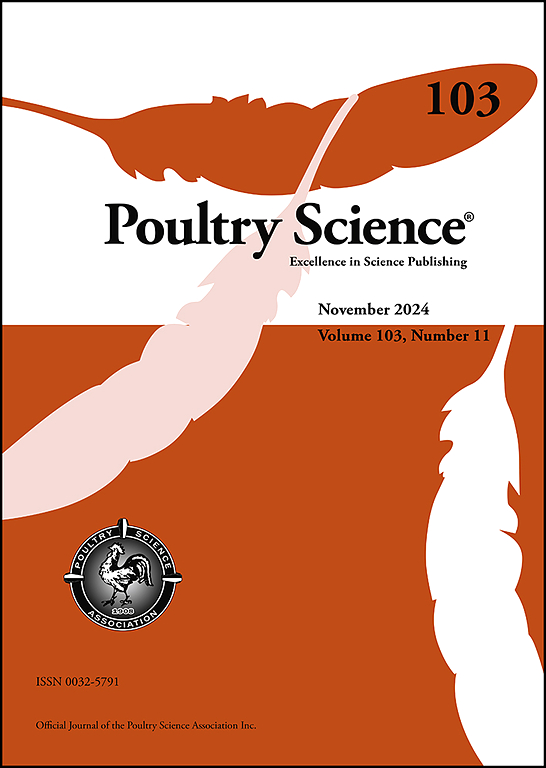研究说明:研究商品肉鸡慢性肠道应激源的新框架。
IF 4.2
1区 农林科学
Q1 AGRICULTURE, DAIRY & ANIMAL SCIENCE
引用次数: 0
摘要
传统的实验模型通常无法捕捉商业环境中存在的多因素压力源,从而限制了它们的生态有效性。本研究引入了一种新的模型,旨在通过在运营肉鸡鸡舍内集成迷你栏,并在固定时间点(第21天和第28天)将艾美耳球虫细菌肠炎(BE)评分和总平均病变评分(TMLS)作为肠道健康指标,复制累积生产压力。在该模型中,鸟类被喂食富含非淀粉多糖(NSPs)的饲粮,而不添加酶,以诱导慢性肠道应激(CS)。性能指标和肠道健康指标(BE和TMLS评分)在三种环境下进行了比较:CS鸟类、传统生产农场和受控研究设施(后两种环境中的鸟类喂食标准玉米/大豆饲料)。在第35天,CS组的鸡明显比研究设施组的鸡更轻(1.999 kg),效率更低(饲料转化率:1.642),这可能代表了最大的遗传潜力(2.751 kg,饲料转化率:1.268)。与研究农场(2.25)和生产农场(2.12)相比,CS组在第21天的细菌性肠炎评分最高(3.75),但与行业报告的生态失调水平一致。然而,有趣的是,第21天和第28天之间的相对减少只有在CS和PF组之间相似(~ 12%),但在RF组中明显(56%),可能反映了在典型研究条件下缺乏累积应激源。总的显微病变评分(TMLS)总体上仍然很低,尽管CS在第21天(1.38)和第28天(1.12)与常规生产农场(分别在第21天和第28天为0.63和0.38)相比略有升高。组织学分析显示,CS与常规生产农场之间的绒毛与隐窝比率无显著差异,表明生理上的可比性。因此,CS模型成功捕获了现实的亚临床肠道应激,弥合了实验室条件和商业实践之间的差距。它为评估针对肠道健康的营养和管理干预措施提供了一个生态有效的平台。本文章由计算机程序翻译,如有差异,请以英文原文为准。
Research note: a novel framework for investigating chronic intestinal stressors in commercial broiler chickens
Traditional experimental models typically fail to capture the multifactorial stressors present in commercial environments, limiting their ecological validity. This study introduces a novel model designed to replicate cumulative production pressures by integrating mini-pens within an operational broiler house and applying bacterial enteritis (BE) scores and total mean lesion scores (TMLS) for Eimeria spp. as intestinal health indicators at fixed time points (days 21 and 28), where birds were subjected to a diet rich in non-starch polysaccharides (NSPs) without enzyme supplementation to induce chronic intestinal stress (CS). Performance metrics and intestinal health indicators (BE and TMLS scores) were compared across three environments: CS birds, a conventional production farm and a controlled research facility (the birds in the latter two were fed a standard corn/soybean diet). At day 35, birds in the CS setup were significantly lighter (1.999 kg) and less efficient (feed conversion:1.642) than the research facility birds, representing perhaps the maximum genetic potential (2.751 kg, feed conversion: 1.268). Bacterial enteritis scores at day 21 were highest in the CS group (3.75), compared to the Research Farm (2.25) and Production Farm (2.12), but in line with industry-reported dysbiosis levels. However, and interestingly, the relative reduction between day 21 and day 28 was similar only between the CS and the PF (∼12 %) but pronounced in the RF group (56 %), likely reflecting the absence of cumulative stressors under typical research conditions. Total microscopic lesion scores (TMLS) remained low overall, although they were slightly elevated in CS at both days 21 (1.38) and 28 (1.12), relative to the conventional Production Farm (0.63 and 0.38 at days 21 and 28, respectively). Histological analysis showed no significant differences in villus-to-crypt ratios between CS and the conventional production farm, suggesting physiological comparability. Thus, the CS model successfully captured realistic subclinical gut stress, bridging the gap between laboratory conditions and commercial practices. It provides an ecologically valid platform for evaluating nutritional and management interventions targeting gut health.
求助全文
通过发布文献求助,成功后即可免费获取论文全文。
去求助
来源期刊

Poultry Science
农林科学-奶制品与动物科学
CiteScore
7.60
自引率
15.90%
发文量
0
审稿时长
94 days
期刊介绍:
First self-published in 1921, Poultry Science is an internationally renowned monthly journal, known as the authoritative source for a broad range of poultry information and high-caliber research. The journal plays a pivotal role in the dissemination of preeminent poultry-related knowledge across all disciplines. As of January 2020, Poultry Science will become an Open Access journal with no subscription charges, meaning authors who publish here can make their research immediately, permanently, and freely accessible worldwide while retaining copyright to their work. Papers submitted for publication after October 1, 2019 will be published as Open Access papers.
An international journal, Poultry Science publishes original papers, research notes, symposium papers, and reviews of basic science as applied to poultry. This authoritative source of poultry information is consistently ranked by ISI Impact Factor as one of the top 10 agriculture, dairy and animal science journals to deliver high-caliber research. Currently it is the highest-ranked (by Impact Factor and Eigenfactor) journal dedicated to publishing poultry research. Subject areas include breeding, genetics, education, production, management, environment, health, behavior, welfare, immunology, molecular biology, metabolism, nutrition, physiology, reproduction, processing, and products.
 求助内容:
求助内容: 应助结果提醒方式:
应助结果提醒方式:


